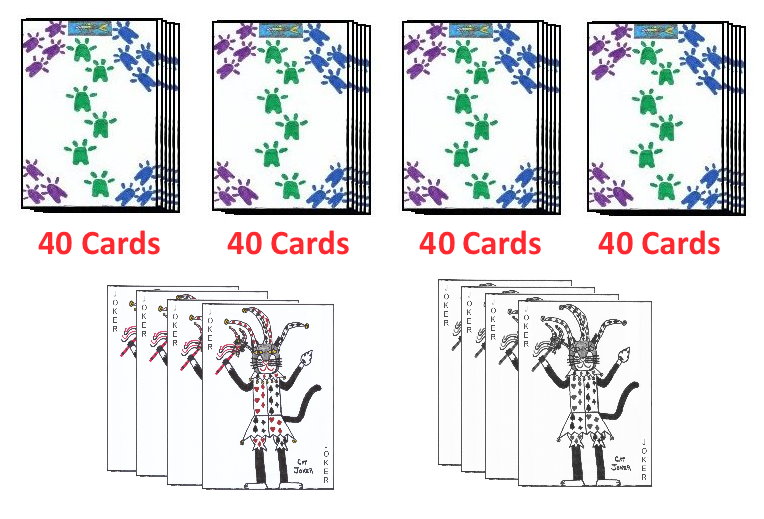
Bao Huang is a Chinese card game of the climbing family which is popular in much of northern China as well as
commonly played online. The name of this game translates to "Protect the Emperor" but is also sometimes shortened to just
Diwang (Emperor).
Bao Huang is designed for play by five players using a large 168 card deck. This deck can be created by combining four standard 52 card decks together after having removed all the cards of denomination 3, 4, and 5 from those decks. In addition, a total of eight Jokers are added to this deck, four black and white Jokers and four color Jokers. One black and white Joker and one color Joker should also be marked in a simple way to distinguish that as a special card. Thus, one of the color Jokers should be marked as the Emperor and one of the black and white Jokers should be marked as the eunuch or Emperor's protector. These cards will have special significance to the player or players to whom they are dealt. The ranking of the cards in the large deck used for this game are as follows (from high to low): color Joker, black and white Joker, 2, Ace, King, Queen, Jack, 10, 9, 8, 7, 6, 5, 4, 3. In all other aspects this variant is played
identically to the base game as described above.
color Joker, black and white Joker, 2, Ace, King, Queen, Jack, 10, 9, 8, 7, 6.
Any method can be used to determine the seating positions of the players at the table as well as the player who will shuffle the cards. Once the players are seated at the table, one designated player will thoroughly shuffle the deck and place it in a stack face-down in the center of the table. The traditional Chinese method of "Dealing" is usually used for distribution of cards in this game. The player to the immediate right of the player who shuffled the cards, then cuts the cards, and the player to the immediate right of that player will begin taking cards from the deck. Thus, in this method, each player, starting with that player will take one card from the top of the stock adding it to his hand. This continues in a counter-clockwise direction around the table until the entire deck has been drawn. At the end of this draw, some players will have one more card than other players, which is ok (some players will have 34 such cards and some 35). Players of this game should get accustomed to having hands containing a large number of cards.
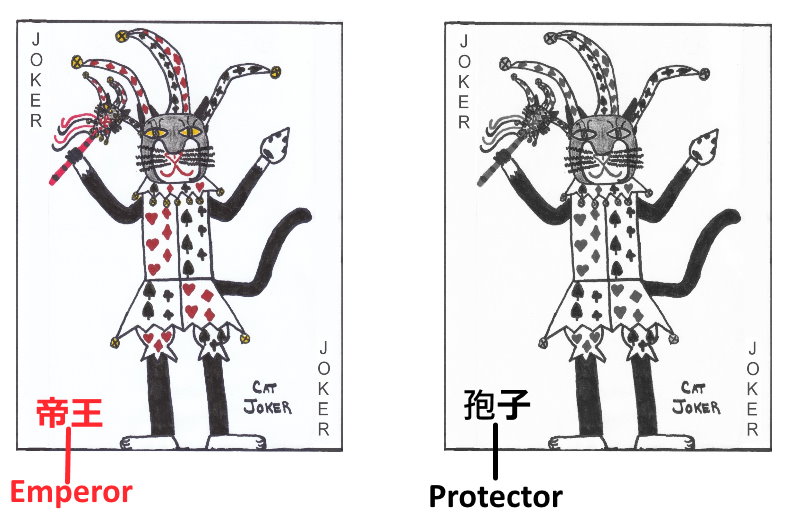
After the cards have been dealt, the player who has, in hand, the marked color Joker is set as the Emperor for this hand. The player who has the specially marked black and white Joker card is set as the Eunuch or Emperors protector. The identity of the Emperor will be quickly known, however the player with the Eunuch card should not make his role known to the other players.
If the player who has the Emperor card chooses not to be the Emperor for the hand he may opt to pass the card to the player to his immediate left. The player to whom this card is passed may then, if he wants to be the Emperor for the hand, take the card into his own hand. He does not give any cards in return for the Emperor card. However, if the player to whom the card is passed also elects not to be the Emperor for the hand, he also may pass the card to his left. This may continue around the table until a player elects to be the Emperor, taking the card into his hand. However if the Emperor card rotates completely around the table, from player to player, and is passed again to the original player it was dealt, that player must take the card back into his hand and set as the Emperor for the hand. The player who was dealt the Eunuch card will then, without revealing this fact to the other players, attempt to assist the Emperor in winning the hand. Thus, the game is a sort of partnership game with the Emperor and the Eunuch playing as partners against the other three players, known as the commoners or farmers. The identify of the Eunuch will usually not be known until that card is played by the
possessor of that card. If the same player has both the Emperor card and Eunuch card, he may either attempt to pass the Emperor card to the player as his left, or he may attempt to play solo against the other four players (who will not usually know that player has both cards).
Before play of the hand begins, one or more players may declare their allegiance, which will reveal their specific identity. Thus, one or more farmers may indicate their allegiance as opponents to the Emperor. If this occurs, which is called an uprising, the score for the hand will be doubled. Similarly, the player who has the Eunuch card may declare his allegiance to the Emperor player which will double the score. If both, one or more farmers declare their allegiance and the Eunuch declares his allegiance, the score is quadrupled. If the same player has both the Emperor and Eunuch card, he may also declare this which will double the score for the hand, in addition to another potential double if one or more of the farmer players declare their allegiance.
The object of the game is to be the first team (either the Emperor and the Eunuch or the three farmers) to first run out of cards, with the team to first do so declared the winner of the hand.
The player who currently has the Emperor card makes the first play to the table. This player may make any legal combination consisting of one or more cards. The following are the playable combinations in Bao Huang:
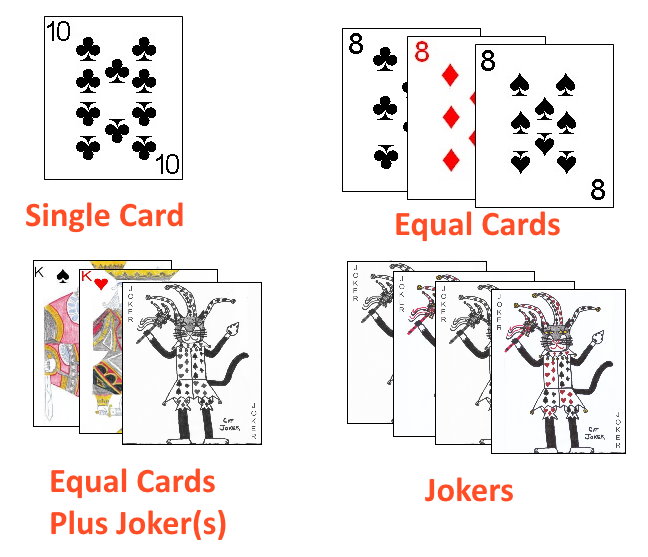
- Single Card:
This consists of any single card from the player's hand. A play of a single card can be beat by any higher ranked single card as per the card ordering given previously.
- Equal Cards:
This combination is two or more cards of the same rank (suit being irrelevant), but not including any Jokers.
- Equal Cards Plus Jokers:
This is a combination of one or more normal cards with one or more Jokers (of the same color or differing colors).
- Jokers:
One or more Jokers, which can be of the same color or of differing colors.
For any combination consisting of two or more cards, the combination can be beaten by a legal combination which consists of the exact same number of cards and for each of the cards in the original combination, a different card from the new combination is higher in rank (as per the card ranking given above).
Thus, after a player plays the first combination, each player in turn (in a counterclockwise order) has two options. He may either player a combination of the same number of cards which can beat that combination or may pass. If the player plays a higher combination, the next player in turn must then play a still higher combination or pass. This continues until, after a combination is played, the remaining four players all pass in turn (either because they do not have a higher combination or are unwilling to play a higher combination). A player that has previously passed on the same round is not barred from playing when able on a further turn if he prefers. Once a valid play is followed by four consecutive passes in sequence, the player who played that last high sequence then starts a new combination, playing any card from his hand.
If a player through legal plays manages to play his last
card, he drops from the hand and the turn moves to the next player to his right. If the player who has run out of cards would had the highest combination in the last round and it would normally be that player's turn to start the next round, the privilege to start the next round passes to the next active player in a counterclockwise direction around the table from that player. This continues until every player in one of the teams has run out of cards while the opposing team still has at least one member still having cards in hand. At this time the hand ends and the team (either the Emperor's team or the farmer's team) which was the first to have all members of that team run out of cards is declared the winner of that hand.
The actual ongoing scores accumulated for each player on each hand are dependent on the order of finish. If the Emperor had a partner, each player scores based on the order of finishing during the hand (regardless of the team which that player was a part of). The following chart shows the scoring based on this finishing order:
| Finishing Order | Game Points Score |
|---|
| First | +2 Points |
| Second | +1 Points |
| Third | 0 Points |
| Fourth | -1 Points |
| Fifth | -2 Points |
|
|
 |
It should be noted that more than one player may still have cards after one team has finished, the hand will still end, and these players are simply determined to finish in the last positions (for purposes of calculating points to a team at the end of the hand).
The total sum of game points earned by a team should be totaled together, and this total is the number of points each member of that team will receive for the hand.
The Emperor scores double the calculated total for his team, while all other players score the actual number as calculated for that team. If the Eunuch had declared his allegiance before the start of actual play, all game point scores awarded for the hand are doubled, or if one or more farmers had declared their allegiance before the start of actual play, the score is also doubled.
If the Emperor played without the aid of a partner (having both the Emperor and Eunuch cards) and manages to finish first he earns +12 points and each other player must subtract 3 points from their ongoing game score. If the Emperor played alone and finishes second, all players (including the Emperor player) score zero for that hand. If the Emperor played alone and finishes third or later, the Emperor scores -12 game points and each opponent scores + 3 for the hand. If the Emperor had declared he is playing alone, or one or more of the farmers had declared their allegiance, this score is also doubled.
After the first hand of the game, losing players must give tribute to the winning players. After the cards have been dealt, but before any play begins, each member of the team that had lost from the previous hand must place the highest card in his hand that is not a Joker face-down on the center of the table. If the Emperor's team did not win the previous game, he must put his two highest cards in the center of the table. The members of the winning team from the previous hand may then take a card from the table (in the order of having finished in that last hand) and add it to his hand. The Emperor, on the other hand is entitled to take two cards from the table. If the previous hand ended in a 0 game point score, no tribute cards are provided.
After a set number of hands is played, the player with the highest accumulated game point score is declared the game winner.
Full Deck: Some players prefer to not remove the threes, fours and fives from the deck, thus including four full fifty-two card decks and eight total Jokers. This makes for a total deck size consisting of 216 cards. In this version, of course each player will have more cards in hand after all cards have been taken in the initial draw. The ranking of the cards in this extended deck are as follows, from high to low:
Lowest Cards Last:
Another variant which is sometimes encountered is that the lowest ranked cards in the deck must be played last by that player. Thus, a player is not entitled to play cards of that rank until he only has cards in hand of that lowest rank in the deck currently being used. These lowest cards may not be combined with any Jokers on this last play. Other than this change to the rule, the game is played identically to the standard version of the game as described above.
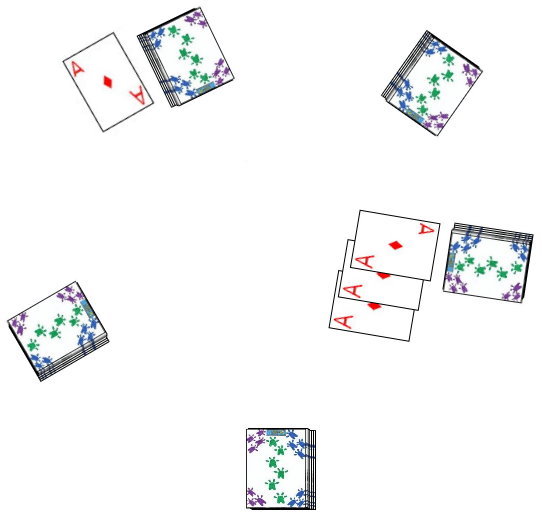 Selection of Emperor's Protector
Selection of Emperor's Protector: Another variant rule which is sometimes played is to modify the method by which the partner of the Emperor player is selected for the hand. If this optional rule is used, the player who receives the marked Emperor Joker must instead show three cards of the same rank and suit from his hand. The player who has the fourth card of that same rank and suit is set as the Emperors protector on the hand (but normally does not state this fact). If the player who is dealt the Emperor card does not have three such cards of the exact same rank and suit, he must pass the Emperor card to his left. A player may also elect to pass the Emperor card even if they do have three such identical cards but do no want to play as the Emperor during the hand. If the Emperor card is passed by every player, with no player accepting the role of Emperor, it is passed in a counter-clockwise around the table to the first player who does have three identical cards, who is set as the Emperor for the hand. If no player has three cards of the same rank and suit in the hand, all the cards are thrown in for a new deal (the same order of play in this new hand). If a player has all four cards of the same rank and suit and has the opportunity to show the Emperor card, he may simply show three and play solo, not telling the other players he has the fourth card of that set (subsequently earning a higher score at the end of the hand if able to win the hand, as described above). Alternatively, that player can show all four cards, making a declaration which earns an even higher bonus score if that player manages to win the hand.
If this variant rule is being used, the marked "black and white" Joker (if that card has been so marked) does not set the player holding that card as the Emperor's Protector and thus has no special role other than being one of the two second highest ranking cards as found in the deck. Other than this alternate method of selecting the Emperor's Protector, in all other aspects, this variant is played identically to the standard game as described in the main section above.
Big A: Big A is another game commonly played in northeastern China, which has a number of similarities to Bao Huang. Big A (short for Big Ace), is played by five players using two standard decks shuffled together and the addition of four total Jokers (two
colored Jokers and two black and white Jokers). The normal ranking of the cards as used to play Big A are as follows, from highest to lowest: Big A (these
special cards will be described below), colored Joker, black and white joker, 3, 2, all other Aces, King, Queen, Jack, 10, 9, 8, 7, 6, 5, 4.
Determination of seating positions and the player to draw the first card can be determined in a number of manners with a draw of high cards a method commonly used. Using that method, players would each draw a card from the shuffled deck (discarding and redrawing any cards of the same rank as other players), and would take seats at the table in the order of cards drawn, from highest to lowest. The player drawing the highest card of all would draw the first card during the deal.
Once the cards have been shuffled, the deck is then placed face-down in the middle of the table. The player designated to draw the first card then draws one card into his hand, and the player at his immediate right would draw the next card, and the players, in a counterclockwise direction around the table would each draw one card a time. This drawing of cards continues until the entire deck has been drawn. Some players may end up with one more card than others, which is expected. The very last card drawn by each player should not be added to that player's hand, but instead left face-down on the table, not yet seen by that or any other player. During this drawing phase, any player who has any Ace in his hand may, but is not required to, expose this card, face-up on the table in front of themselves. This Ace is then set as the "Big A" for that hand. This player is then set as the Declarer for the hand, and whichever other player who has drawn (or will draw), the other identical Ace, will become that player's partner. However, this player would not immediately announce this, so the identify of that player may not be known for some time. If the same player ends up having the second Ace as well, he will then
end up playing solo against the other four players, but he does not necessarily state this once he discovers this fact. He may opt, however to reveal these cards, which will then prevent another player from overcalling him (see below).
After a player has exposed such an Ace, to become the Declarer, another player may, however overcall this by showing two Aces from his hand. Both of these Aces must be of matching suit, but would be a different suit than that of the Ace exposed by a previous player. This player,
exposing the two matching Aces would then be set as the new Declarer, playing solo against the other four players.
Once the Big A has been determined, the players may then pick up their last card, which they had left face-down on the table, and add it to their hand. However, if every player has drawn their cards (except the last face-down card for that player which he has left on the table), and no one has yet exposed an Ace to be the Big A, the first player, in a counter-clockwise direction, starting with the player who drew the first, that has an Ace of hearts, becomes the Declarer, and the other player (if any) who has the identical card, becomes that player's partner. If both Aces of
hearts are part of the face down cards and thus no player currently has
one of these Aces, the face-down cards on the table should be exposed to
verify, the cards thrown in, reshuffled and a new hand dealt.
After the players then pick up their last card, the player who has the other Ace (or if the Declarer has both Aces), may expose the other, identical Ace, if that player prefers. Doing this will thus double the scoring for that hand. In the event that the Big A was not voluntarily set by a player during the draw (but after by the player having the first Ace of hearts), his opponent may not thus expose that card. In addition to setting the partnerships to be used in the game, the two Big A cards are set as the top ranked cards in the game.
The Declarer's partner (if he exposed his Ace) has the first play, however if the player with this second identical Ace has not so exposed the card, the Declarer makes the first play instead. In starting a new series of play, the leader may play any legal combination. Each other player, in a counterclockwise direction after the leading player must then, on their turn, either pass or play a combination of the same type, but higher ranking, or play a higher ranking bomb. The following are the legal combination types that can be played in Big A:
| Combination Type | Description | Example |
|---|
| Single Card | This is one card of any rank. In order to be beaten by another single card, subsequent players must player a single card of a higher rank. | 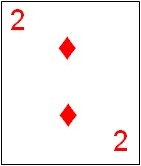 |
| Pair | This is a pair of any two cards of the same rank (they need not be of the same suit). In order to be beaten by another such pair, this other pair must be of higher ranked cards. A pair of Jokers or Big A's is not considered a Pair, but rather a Bomb (see below). A pair consisting of one Big A, and any other Ace, is considered a normal pair of Aces. | 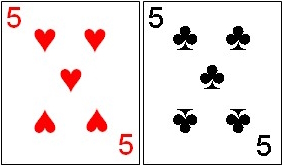 |
| Sequence | This combination consists of three or more cards in direct sequential order (regardless of the suit of those cards). In order for a subsequently played sequence to be considered higher, it must contain the exact same number of cards, but the highest card in the sequence must be higher than the highest card in the previous sequence. Note that for purposes of sequences, the cards have a slightly different, more traditional ranking, as follows
(from low to high): Ace, 2, 3, 4, 5, 6, 7, 8, 9, 10, Jack, Queen, King, Ace. Jokers can never be used in a sequence, and a Big A in a sequence is considered a regular Ace.
It should be noted that in sequences, an Ace can be considered either
high or low. |  |
| Double Sequence | A double sequence is combination which consists of a sequence (consisting of at least three cards), in which each card in that sequence is paired with another card of that same rank. In order to beat a double sequence, the subsequent sequence must consist of the exact same number of cards, but have a higher last card in the sequence. The ranking of cards as used in a double sequence is the same as that in a standard sequence. | 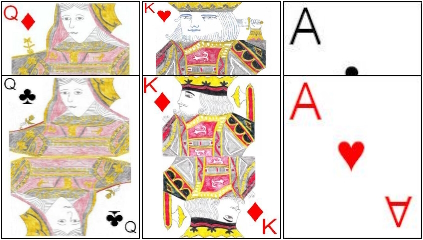 |
While with these normal combinations, in order for another player to beat that play, they must play a combination of the same type and same number of cards. However, there are other types of combinations, called bombs, that, if played, can
usually beat any normal combination. A bomb can never be beat by a normal combination, but can be beat by a higher ranked bomb. The following are the legal bomb combinations that can be played and their ranking (listed from lowest to highest):
| Bomb Type | Description | Example |
|---|
| Egg (Triplet) | This is three cards, all of the exact same rank. This bomb can beat any single card of rank lower than a Joker, any Pair or sequence, or any triplet that consists of lower ranked cards. If the triplet contains any Big A's these are considered regular Aces. | 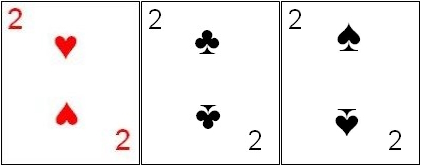 |
| Four of a Kind (Big Egg 1) | This bomb consists of four cards, all of the same rank.
A combination of Four Jokers, however, is considered a higher
ranking bomb, see further below. A Four of a kind can beat any other four of a kind of lower ranked cards, any single card (except
one Big A), any pair, sequence, double sequence, or triplet. |  |
| Five of a Kind (Big Egg 2) | This is a combination of cards consisting of five cards, all of the exact same rank. This bomb can beat any normal combination of any type, any lower ranked five of a kind, and any lower ranked bombs (triple or four of a kind). |  |
| Six of a Kind (Big Egg 3) | This combination consists of six cards, all of the exact same rank. This combination can beat any six of a king consisting of lower ranked cards, any normal combination and any lower ranked bombs. | 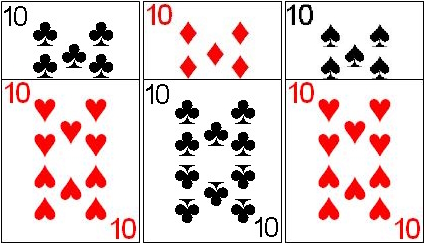 |
| Two Jokers | This combination consists of any two Jokers. Two Colored Jokers can beat two black and white Jokers or two mixed Jokers. This combination can also beat any lower ranked bomb or any normal combination. | 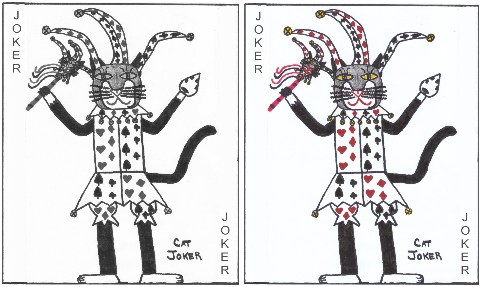 |
| Triplet Sequence | This nine card combination consists of a
sequence of three cards, with each card in that sequence being found in triplicate. A triplet sequence can beat any other triplet sequence consisting of lower ranked cards, as well as any other lower ranked bomb or any normal combination. The ranking of the cards, for purposes of triplet sequences is the same as found in a standard sequence. | 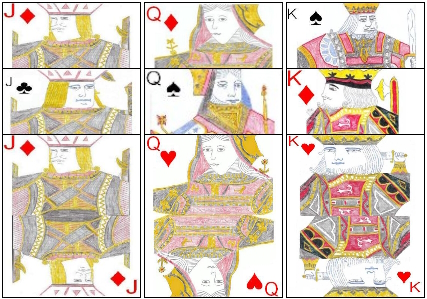 |
| Fake Eight | A fake eight is an eight card combination consisting of two cards in direct sequence, with each of these two cards having four total copies of that ranked card. This combination can beat any lower ranked fake eights, as well as any lower ranked bomb or normal combination. The ranking of the cards, for use in this sequence type combination are the same as found in the other sequence types. | 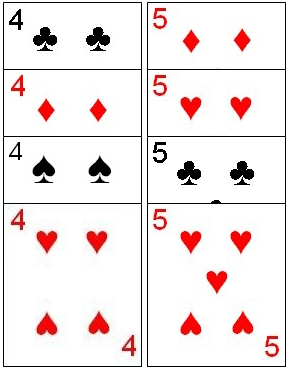 |
| Seven of a Kind | This combination consists of exactly seven cards of the exact same rank. This combination can beat any seven of a kind consisting of lower ranked cards, any lower ranked bomb or any normal combination. |  |
| True Eight (Eight of a Kind) | This combination consists of all eight cards of the exact same rank. This combination beats any lower true eight, any lower ranked bomb, or any normal combination. |  |
| Three Jokers | This consists of any three Jokers. This combination beats any
other combination except for four Jokers, or a pair of Big A's. |  |
| Four Jokers | This combination consists of all four Jokers. This is the second highest legal combination and can beat any other combination or bomb, except a pair of Big A's. |  |
| Big Ace Pair | This is the highest possible combination in the game, and consists of the two Big A's. Obviously, this combination could only be played by a player who is playing without a partner. | 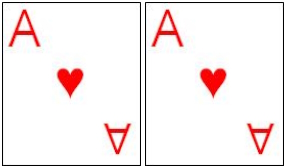 |
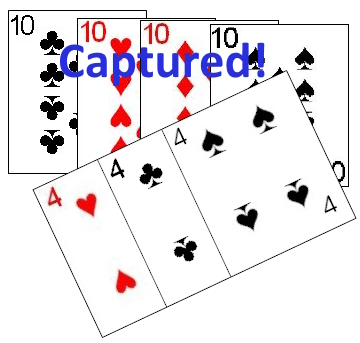
In addition to the bombs, sets of two or more cards, of rank four, also be
used in special circumstances. A set of two or more cards, all in the rank of "four" can be used to "capture" certain other combinations. If the last high play to the table was an Egg or Big Egg, a player can play a number of these fours, which is one less than the number of cards in that combination. In doing so, on his turn, if he plays this combination of fours to the table, he may then add that previous combination from the table into his hand. The played fours, then becomes the new combination that the next players in rotation must attempt to beat, if able and willing. A player may play fours as part of normal combinations as well, and no number of fours can be used to capture seven or more cards of the same type. If a Big A is captured in this way, this does not change the partnerships or the identity of the Declarer as determined at the beginning of that hand.
Play continues around the table from player to player, with players either passing or playing a higher combination than the last as played in the current series. If a player passes, they may still play on further turns on that (or another) series. If, after a player plays a combination, all other active players pass, this ends that series. The cards on the table are set aside out of play, and the last player to make a legal play
on that series may start the next series, playing any legal combination of cards from their hand to the table.
Once a player, on his turn, manages to play the last of his cards
through legal plays, that player then drops from the game. If the player
to run out of cards, plays a combination that cannot be beaten, the lead
would then start with the next player in turn that is not that
player's partner (if that is yet known). The remaining players with
cards continue play, with the hand continuing until either both the
Declarer and his partner both run out of cards, or all the opponents of
the Declarer and his partner run out of cards. Once this situation
occurs, scoring for the hand occurs. The scoring for each player (both
positive and negative) is based on the finishing order of the Declarer's
team on that hand. The following chart shows the possible scoring combinations during the game:
| Declarer's Finishing Order | Declarer's Partner Finishing Order | Declarer's Score | Declarer's Partner Score | Each Opponent's Score | Declarer's Score (if both Big A Exposed) | Declarer's Partner Score (if both Big A Exposed) | Opponent's Score (if both Big A Exposed) |
|---|
| First | Second | 6 | 3 | -3 | 9 | 9 | -6 |
| Second | First | 6 | 3 | -3 | 9 | 9 | -6 |
| First | Third | 4 | 2 | -2 | 6 | 6 | -4 |
| Third | First | 4 | 2 | -2 | 6 | 6 | -4 |
| First | Fourth | 2 | 1 | -1 | 3 | 3 | -2 |
| Fourth | First | 2 | 1 | -1 | 3 | 3 | -2 |
| First | Fifth | 0 | 0 | 0 | 0 | 0 | 0 |
| Fifth | First | 0 | 0 | 0 | 0 | 0 | 0 |
| Second | Third | 0 | 0 | 0 | 0 | 0 | 0 |
| Third | Second | 0 | 0 | 0 | 0 | 0 | 0 |
| Second | Fourth | 0 | 0 | 0 | 0 | 0 | 0 |
| Fourth | Second | 0 | 0 | 0 | 0 | 0 | 0 |
| Second | Fifth | -2 | -1 | 1 | -3 | -3 | 2 |
| Fifth | Second | -4 | -2 | 2 | -6 | -6 | 4 |
| Third | Fourth | 0 | 0 | 0 | 0 | 0 | 0 |
| Fourth | Third | 0 | 0 | 0 | 0 | 0 | 0 |
| Third | Fifth | -2 | -1 | 1 | -3 | -3 | 2 |
| Fifth | Third | -4 | -2 | 2 | -6 | -6 | 4 |
| Fourth | Fifth | -6 | -3 | 2 | -9 | -9 | 6 |
| Fifth | Fourth | -6 | -3 | 3 | -9 | -9 | 6 |
If the Declarer played solo (had both Big A's in his hand), the scoring would be as follows:
| Declarer's Finishing Order | Declarer's Score | Each Opponent's Score | Declarer's Score (if Both Big A Exposed) | Each Opponent's Score (if Both Big A Exposed) |
|---|
| First | 32 | -8 | 64 | -16 |
| Second | 0 | 0 | 0 | 0 |
| Third | 0 | 0 | 0 | 0 |
| Fourth | 0 | 0 | 0 | 0 |
| Fifth | -32 | 8 | -64 | 16 |
After a set number of hands, or amount of time, every player's score is compared, and the player with the highest accumulated score is declared the overall game winner.
Copyright © 2015
CatsAtCards.com. All rights reserved.
 Bao Huang is a Chinese card game of the climbing family which is popular in much of northern China as well as
commonly played online. The name of this game translates to "Protect the Emperor" but is also sometimes shortened to just
Diwang (Emperor).
Bao Huang is a Chinese card game of the climbing family which is popular in much of northern China as well as
commonly played online. The name of this game translates to "Protect the Emperor" but is also sometimes shortened to just
Diwang (Emperor).
 After the cards have been dealt, the player who has, in hand, the marked color Joker is set as the Emperor for this hand. The player who has the specially marked black and white Joker card is set as the Eunuch or Emperors protector. The identity of the Emperor will be quickly known, however the player with the Eunuch card should not make his role known to the other players.
After the cards have been dealt, the player who has, in hand, the marked color Joker is set as the Emperor for this hand. The player who has the specially marked black and white Joker card is set as the Eunuch or Emperors protector. The identity of the Emperor will be quickly known, however the player with the Eunuch card should not make his role known to the other players.


 Selection of Emperor's Protector: Another variant rule which is sometimes played is to modify the method by which the partner of the Emperor player is selected for the hand. If this optional rule is used, the player who receives the marked Emperor Joker must instead show three cards of the same rank and suit from his hand. The player who has the fourth card of that same rank and suit is set as the Emperors protector on the hand (but normally does not state this fact). If the player who is dealt the Emperor card does not have three such cards of the exact same rank and suit, he must pass the Emperor card to his left. A player may also elect to pass the Emperor card even if they do have three such identical cards but do no want to play as the Emperor during the hand. If the Emperor card is passed by every player, with no player accepting the role of Emperor, it is passed in a counter-clockwise around the table to the first player who does have three identical cards, who is set as the Emperor for the hand. If no player has three cards of the same rank and suit in the hand, all the cards are thrown in for a new deal (the same order of play in this new hand). If a player has all four cards of the same rank and suit and has the opportunity to show the Emperor card, he may simply show three and play solo, not telling the other players he has the fourth card of that set (subsequently earning a higher score at the end of the hand if able to win the hand, as described above). Alternatively, that player can show all four cards, making a declaration which earns an even higher bonus score if that player manages to win the hand.
Selection of Emperor's Protector: Another variant rule which is sometimes played is to modify the method by which the partner of the Emperor player is selected for the hand. If this optional rule is used, the player who receives the marked Emperor Joker must instead show three cards of the same rank and suit from his hand. The player who has the fourth card of that same rank and suit is set as the Emperors protector on the hand (but normally does not state this fact). If the player who is dealt the Emperor card does not have three such cards of the exact same rank and suit, he must pass the Emperor card to his left. A player may also elect to pass the Emperor card even if they do have three such identical cards but do no want to play as the Emperor during the hand. If the Emperor card is passed by every player, with no player accepting the role of Emperor, it is passed in a counter-clockwise around the table to the first player who does have three identical cards, who is set as the Emperor for the hand. If no player has three cards of the same rank and suit in the hand, all the cards are thrown in for a new deal (the same order of play in this new hand). If a player has all four cards of the same rank and suit and has the opportunity to show the Emperor card, he may simply show three and play solo, not telling the other players he has the fourth card of that set (subsequently earning a higher score at the end of the hand if able to win the hand, as described above). Alternatively, that player can show all four cards, making a declaration which earns an even higher bonus score if that player manages to win the hand.















 In addition to the bombs, sets of two or more cards, of rank four, also be
used in special circumstances. A set of two or more cards, all in the rank of "four" can be used to "capture" certain other combinations. If the last high play to the table was an Egg or Big Egg, a player can play a number of these fours, which is one less than the number of cards in that combination. In doing so, on his turn, if he plays this combination of fours to the table, he may then add that previous combination from the table into his hand. The played fours, then becomes the new combination that the next players in rotation must attempt to beat, if able and willing. A player may play fours as part of normal combinations as well, and no number of fours can be used to capture seven or more cards of the same type. If a Big A is captured in this way, this does not change the partnerships or the identity of the Declarer as determined at the beginning of that hand.
In addition to the bombs, sets of two or more cards, of rank four, also be
used in special circumstances. A set of two or more cards, all in the rank of "four" can be used to "capture" certain other combinations. If the last high play to the table was an Egg or Big Egg, a player can play a number of these fours, which is one less than the number of cards in that combination. In doing so, on his turn, if he plays this combination of fours to the table, he may then add that previous combination from the table into his hand. The played fours, then becomes the new combination that the next players in rotation must attempt to beat, if able and willing. A player may play fours as part of normal combinations as well, and no number of fours can be used to capture seven or more cards of the same type. If a Big A is captured in this way, this does not change the partnerships or the identity of the Declarer as determined at the beginning of that hand.